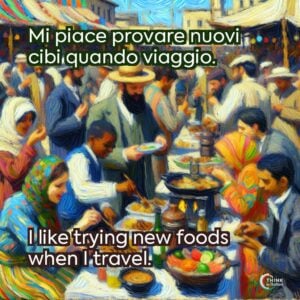Food in Italian
One of the most common reasons my students are learning Italian is their love for Italian cuisine. They want to dive deeper into the culinary traditions of Italy and learn the language to better understand them.
Of course, food is a very important aspect of Italian culture, so it is crucial that you learn the relevant vocabulary for food. So, let me start with the basics: in Italian, the word for “food” is cibo.
It is commonly used in its singular form, also when referring to a plurality of items. However, just like in English, you can also find it in its plural form, although it is less common.
Il cibo italiano è delizioso.
Italian food is delicious.
Mi piace provare cibi nuovi.
I like to try new foods.
Other Words Related to Cibo
In addition to cibo, there are some other useful terms related to food in Italian:
- Pasto: this means “meal” and is used to refer to specific eating occasions.
Ho fatto un pasto leggero.
I ate a light meal.
- Alimenti: this is a more formal word for food, often used in reference to groceries or foodstuffs.
Gli alimenti biologici sono più sani.
Organic foods are healthier.
- Cucina: this word means both “kitchen”, and “cuisine”, used to refer to a style of cooking.
La cucina italiana è famosa in tutto il mondo.
Italian cuisine is famous all over the world.
Idioms With Food
Italian is a language rich in idiomatic expressions, and you should not be surprised to find out that many of these are connected to food.
Essere pieno come un uovo.
To be full like an egg.
This phrase means to be very full after eating. You might hear it after a big meal, especially during family gatherings or festive occasions.
Rendere pan per focaccia.
To give bread for focaccia.
This is the Italian equivalent of “an eye for an eye”, meaning to get revenge.
Non tutte le ciambelle escono col buco.
Not all doughnuts come out with a hole.
This means that not everything turns out as expected, much like how doughnuts sometimes come out of the oven without their signature hole.
The Role of Food in Social Interactions
In Italy, food is not just about nourishment, it’s about connection. Meals are often central to social gatherings, and the language Italians use around food reflects this strong sense of togetherness.
For me, sharing a meal is one of the main ways I build and strengthen relationships with people. We deeply value these moments, whether it’s a casual pranzo (lunch) or a more formal cena (dinner).
In families, meals are the moment when people share their lives. I remember having dinner with my parents and my brother at the end of a long day, updating each other about how our day went.
We used to start with a simple buon appetito (enjoy your meal) and then we shared thoughts, ideas, or also just opinions revolving around the food itself.
Why Food Matters to Italian Learners
Italian cuisine is often the first introduction many people have to the country’s culture. By learning the language, you can deepen your appreciation for the food itself and the culture behind it.
One of my students was inspired to learn Italian after traveling through Tuscany. She fell in love with the local food and realized that learning the language would help her better understand the recipes and traditions she encountered.
Now, she uses her Italian skills to connect with local chefs, read traditional cookbooks, and even recreate Tuscan dishes at home.
By learning food-related vocabulary, you’re not just expanding your language skills: you’re opening the door to a richer, more immersive experience of Italian culture.






